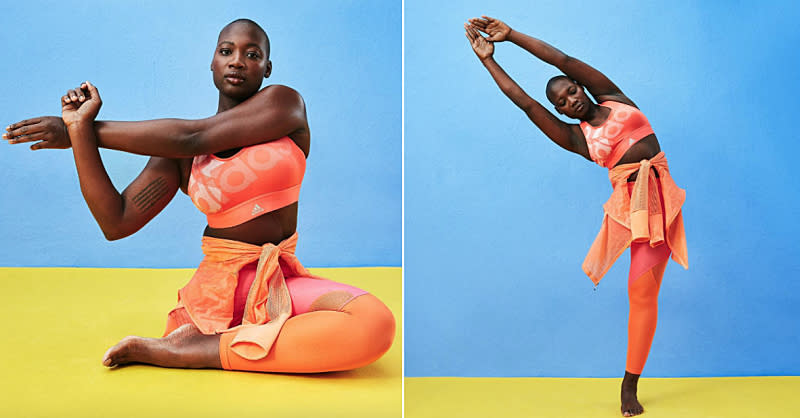Everything you need to know about the amputee model in the new inclusive ASOS campaign

A few weeks ago, ASOS launched a new activewear campaign called “More Reasons to Move.” And while the extremely diverse cast of models is overflowing with inspiration — from the gender-nonconforming black DJ who learned to accept himself through ballroom dance to the plus-size model and boxer — there’s one woman we were particularly struck by both because of her beauty and her story.
That woman is Mama Cāx, and she is an amputee. She’s featured in the campaign video and on their website, and is now on billboards across London. The brand shared another photo of her last week stretching and standing on her one leg while looking stunning in bright orange workout gear, further igniting an infatuation with her.
Keeping fierce > keeping fit #MoreReasonsToMove #ASOS #ASOSActivewear
A post shared by ASOS (@asos) on Jan 26, 2018 at 6:49am PST
Cāx is a 28-year-old model, blogger, activist, and motivational speaker. She moved from Haiti to New York City in 2005 and shortly after, was diagnosed with bone cancer that had metastasized to her lungs. She was told she only had a few weeks to live. But after a failed “spiritual surgery” in Brazil, she continued with chemotherapy and at age 16, was told she needed to amputate part of her leg to beat the disease. So she did.
“For the past few years, I’ve been blogging while getting a master’s in international studies,” she tells Yahoo Lifestyle. “I’m fairly new to the modeling world — I was signed with JAG Models in October 2017.” Since then, she’s worked with a couple of “amazing brands,” including Fenty Beauty and Google.
If you’re a big fan of ASOS, like Cāx, you might recognize her. “I’m a longtime fan of the brand. I’ve probably been shopping there since college,” she says. “I’ve collaborated with ASOS in the past when I served as a panelist in one of their events last year and was also featured in a six-page spread in their fall 2017 magazine.”
The activewear campaign shows her with and without her prosthetic leg in yoga poses, which she started doing after her amputation to “help alleviate her chronic [back] pain,” ASOS shared on Instagram.
A post shared by ASOS (@asos) on Jan 16, 2018 at 1:09am PST
But she wasn’t always so comfortable exposing her disability. “It’s hard to pinpoint the exact moment I decided to even expose my prosthetic, but all throughout college, I had it covered,” Cāx told Yahoo Lifestyle in a previous interview. “It wasn’t until … I connected with other girls who were amputees. I thought, wouldn’t life just be easier if I accepted this and didn’t have to hide it?”
She continued: “At the beginning, it was really hard, because it was a lot of stares, and at that point, I didn’t have the stylish cover [from a line of fashion-forward prosthetic covers marketed by Alleles in Canada]. I would get a lot of stares and rude comments, and so it was a long and painful road to get where I am now. But I think it got to the point where my confidence was just showing, and people were afraid to ask questions that would be perceived as stupid.”
As Cāx has learned to love her uniqueness, so has the fashion industry. And ASOS has been a major player in making modeling more inclusive (remember when they low-key launched a bunch of swimwear pics featuring models with stretch marks?) “Aside from my photograph, the range of models chosen to represent different bodies is a true representation of our diversity, be it ethnicity, body type or ability,” Cāx says of the ASOS campaign. “Many of the models featured are the complete opposite of what has been the ideal in the industry. For a long time, disability has been lacking from the fashion industry. It’s nice to see some brands hire models with visible disabilities and great to see a few design accessible attire with disability in mind.”
While this is a major moment for ASOS, the industry as a whole still has a long way to go. “There’s still a lack of representation, but at least we are taking baby steps. With fashion, things can easily change,” Cāx says.
She adds: “Therefore it’s important to treat inclusivity and diversity like a must and not a trend. I’m excited to see what’s to come.”
We would be too if our images were plastered all over the place — including on buses, in subways, and on billboards in London — for a major retailer’s game-changing campaign. “My friends who live in London were just ecstatic to see the ads on billboards, and my followers with disabilities were simply excited to finally see someone they could relate to,” Cāx says. “The response has just been overwhelmingly positive.”
Read more from Yahoo Lifestyle:
This college student is proving ‘acne is normal’ provocative photo series
Body-positive blogger explains why you shouldn’t call disabled people ‘an inspiration’
Woman overcame her body image issues to become a work of art
Follow us on Instagram, Facebook, and Twitter for nonstop inspiration delivered fresh to your feed, every day.

